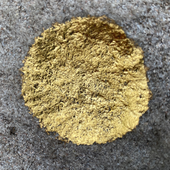herman de vries, traces of gold in the landscape
- Or Cadre
- Dec 18, 2021
- 3 min read
Updated: Jan 1, 2022
Golden words in the landscape, this is very quickly summarized the art of Herman de Vries. His artistic work is both a reflection on the universality of the landscape, the contemplation of nature and the place of the artistic gesture. A gesture where gold plays its part ...
Herman de vries course
herman de vries was born in Holland in 1931, he lives and works in Eschenau (Germany).
Trained as a horticulturalist, in 1959 he co-founded Groupe Nul, a Dutch minimalist abstract artistic group close to Groupe Zéro, Gutaï and the New Realists.
The basic principles are:
monochrome
repetition
seriality
and direct processing of the material.
All principles that he will keep in his own production. Opposed to the notion of hierarchy (it is for this reason that he never uses capital letters, even in his name), and very influenced by oriental philosophy, for him, nature, art (and gold may I add) are the elements of the same equation.
Contemplation of nature
His approach is similar to that of the naturalist he could have become.
He collects and classifies the leaves, stones, earth, wood and even toponyms, gleaned during his walks and travels. His works sometimes belong to the collection (exhibitions "To be and I am" or "Chance and change") where the natural elements are brought back within the exhibition spaces and become "works". "My poetry is the world" is one of its mottos.
Conversely, he also likes to integrate art into the very heart of landscapes while firmly opposing the notion of land art:
"For Herman de Vries, nature is sufficient in itself and does not need to be embellished by art [...]: 'nature is art', he says, because it is perpetual creation. Of course, the artist must not take nature for a scene on which to display his productions either: "I hate art in nature", says Herman de Vries, whose interventions have, despite appearances, nothing in common with Land Art [...]. "We have strayed so far from nature, we have modified, manipulated, destroyed it so much, we have forgotten so well that it is art par excellence, that only one more artifice, that of human art, can help us find her. Because we have lost all relation of immediacy with nature, we need the additional mediation of art to restore the unity we formed with it "(Anne Moeglin-Delcroix, Extract from Proximity in the distance, Art and nature at herman de vries, herman de vries, Fage editions and Gassendi museum, 2009).
The sensitivity of the place and the artist
Indeed, for Herman de Vries, the artist does not pose as a superior being who has an injunction of expressiveness, but more as a mediator who brings back, at the same time, to the universal natural world and to the spirit of 'a particular place.
Strolling, contemplation, meditation, and an intellectual as well as a sensitive understanding of the place characterize his humble approach (just like that which he expects from his "spectators").
This "registration" in a specific place is done in different ways:
by the various vernacular harvests already mentioned (leaves, earth, stones, etc.)
by carving (golden) words in the very rock of a place
by the concern to use the language of the place (such as the sentence in Provençal engraved at the bottom of the public fountain of the Vieil Esclangon in Haute-Provence "Siáu dins tot çò que viu" or with the words in Sanskrit at the sanctuary of Münster) or Latin.
by paying attention to the history of this place (both archaeological and geological or even with references taken from the small and the great history (such as the sentence of Pierre Gassendi "ambulo ergo sum" on the site of the Roche-Rousse sanctuary) .
Golden word and gesture in nature
The artistic work he carried out on various sites, notably in the Alpes-de-Haute-Provence (Entrages, Trevans, Authon, nature sanctuary of Roche-Rousse), always brings back to the link between stone, history, language and ...gold.
His outlook on the world is strongly influenced by poetry, as well as by Buddhist philosophy, where everything is interrelated: plants and minerals, living beings, artefacts, traditional practices, knowledge of all kinds ... The relationship to the sacred (and not to a religion) is therefore also fundamental to understanding his work.
herman de vries, by his use of gold (such as that of the names of the gilded dead in funerary art):
makes "a" place - and its memory - visible
gives it a "sacred" character
emphasizes a cosmic link
and finally pays him a lasting tribute.
[Photos of herman de vries' works are also on Pinterest].






















































Comments